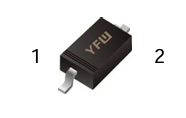Analysis of Switching Diodes 2
Date:2025-06-13 Categories:Product knowledge Hits:363 From:Guangdong Youfeng Microelectronics Co., Ltd
4. Key Parameters
4.1 Reverse - Recovery Time (trr)As mentioned earlier,trrdetermines how fast a
switching diode can turn off when the bias voltage changes from forward to reverse. It is defined as the time interval between the application of a reverse - bias voltage and the time when the reverse current decays to a specified low value.
Diodes with shortertrrvalues are preferred for high - speed digital circuits and high - frequency power converters.
4.2 Forward Voltage Drop (VF)
The forward voltage drop is the voltage across the diode when it is forward - biased and conducting current.
switching diode,
A lowerVFis desirable as it reduces power dissipation in the diode. For example, in power - supply circuits, minimizingVFcan improve the overall efficiency of the system.
4.3 Reverse - Breakdown Voltage (VBR)The reverse - breakdown voltage is the maximum reverse - bias voltage that the diode can withstand without undergoing avalanche breakdown or Zener breakdown. Exceeding this voltage can cause permanent damage to the diode. Different types of switching diodes have differentVBRratings, and the selection of a diode should be based on the maximum reverse - voltage present in the application circuit.
switching diode4.4 Maximum Forward Current (IF)This parameter specifies the maximum continuous forward current that the diode can safely carry without overheating. ExceedingIFcan lead to thermal damage to the diode, reducing its lifespan or causing immediate failure.
5. Applications
5.1 Digital Circuits
In digital circuits,
switching diode are used for logic - level shifting, clamping, and protection. For instance, in a digital logic gate, diodes can be used to ensure that the input and output voltages remain within the proper logic levels. They can also be used to clamp the voltage at a specific level to protect sensitive components from voltage spikes.
5.2 Power Supplies
Switching diodes are essential components in switch - mode power supplies (SMPS). They are used in rectifier circuits to convert alternating current (AC) to direct current (DC). The fast - switching capability of these diodes helps in reducing power losses and improving the efficiency of the power supply. In addition, they are used for free - wheeling in inductive loads, preventing voltage spikes when the current through the inductor is suddenly interrupted.
5.3 Signal Processing
In signal - processing applications, such as radio - frequency (RF) circuits,
switching diode are used for signal modulation, demodulation, and switching. Their ability to rapidly switch between on and off states enables the manipulation of RF signals, which is crucial for communication systems.

Previous:
Classification, Structure, and Principle of MOSFET
Next:
Analysis of Switching Diodes 3
